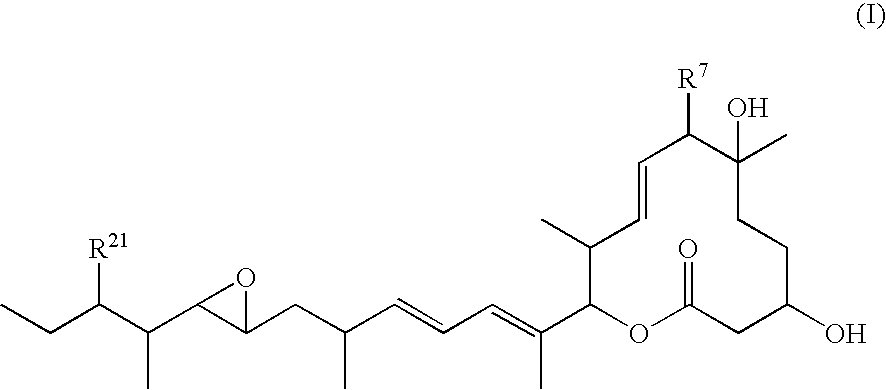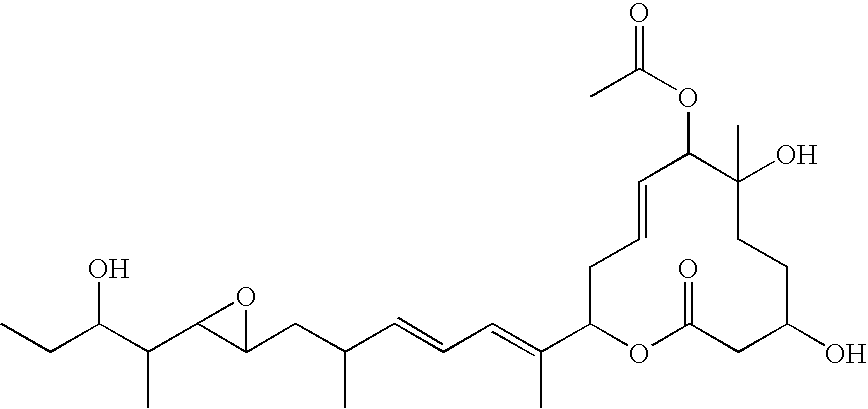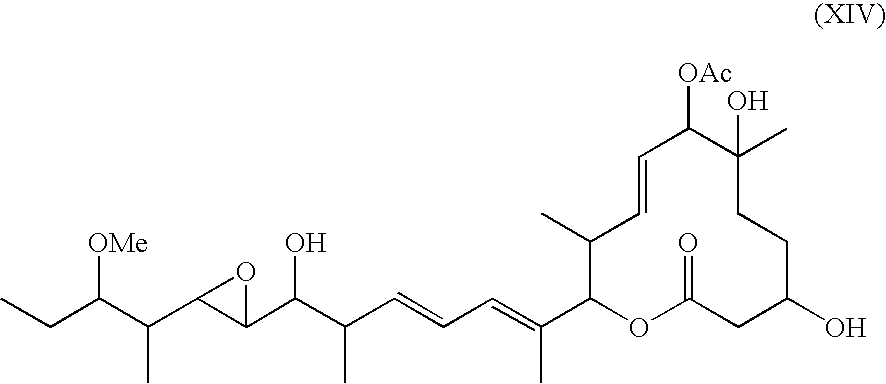Novel physiologically active substance
- Summary
- Abstract
- Description
- Claims
- Application Information
AI Technical Summary
Benefits of technology
Problems solved by technology
Method used
Image
Examples
example 1
(8E,12E,14E)-21-benzoyloxy-3,6-dihydroxy-6,10,12,16,20-pentamethyl-7-((4-methylpiperazin-1-yl)carbonyl)oxy-18,19-epoxytricosa-8,12,14-trien-11-olide (Compound 1)
[0449]
example 1-1
Step
(8E,12E,14E)-7-acetoxy-6,21-dihydroxy-6,10,12,16,20-pentamethyl-3-triethylsiloxy-18,19-epoxytricosa-8,12,14-trien-11-olide
[0450]
[0451] (8E,12E,14E)-7-acetoxy-3,16,21-trihydroxy-6,10,12,16,20-pentamethyl-18,19-epoxytricosa-8,12,14-trien-11-olide: 11107B (Compound of Reference Example 1) (1.0 g, 1.86 mmol) was dissolved in tetrahydrofuran (10 mL). Triethylamine (0.94 mL, 6.74 mmol) and 4-dimethylaminopyridine (117 mg, 0.96 mmol) were added to the solution, and then the solution was cooled to 0° C. Chlorotriethylsilane (0.4 mL) was slowly added to the solution, and the reaction solution was stirred at 0° C. for two hours. The reaction solution was diluted with ethyl acetate (100 mL), and the dilution was washed with purified water (10 mL) three times and brine (10 mL). The resulting organic layer was dried over sodium sulfate, and then filtered. The filtrate was concentrated. The concentrate was purified using silica gel column chromatography (MERCK Silica gel 60, 63 to 200 μm; he...
example 1-2
Step
(8E,12E,14E)-7-acetoxy-21-benzoyloxy-6-hydroxy-6,10,12,16,20-pentamethyl-3-triethylsiloxy-18,19-epoxytricosa-8,12,14-trien-11-olide
[0453]
[0454] (8E,12E,14E)-7-acetoxy-6,21-dihydroxy-6,10,12,16,20-pentamethyl-3-triethylsiloxy-18,19-epoxytricosa-8,12,14-trien-11-olide (101 mg, 156 μmol) was dissolved in methylene chloride (1 mL). 4-dimethylaminopyridine (59.7 mg, 48.9 μmol) was added to the solution, and the solution was cooled to 0° C. Benzoyl chloride (28.0 μL, 241.0 μmol) was added to the solution, and the solution was stirred at room temperature for two hours. The reaction solution was diluted with ethyl acetate (20 mL), and the dilution was washed with purified water (4 mL) twice and brine (4 mL). The resulting organic layer was dried over sodium sulfate, and then filtered. The filtrate was concentrated. The concentrate was purified by silica gel column chromatography (MERCK Silica gel 60, 63 to 200 μm; hexane:ethyl acetate=5:1→4:1) to obtain the title compound (107 mg, 142 ...
PUM
| Property | Measurement | Unit |
|---|---|---|
| Molar density | aaaaa | aaaaa |
| Molar density | aaaaa | aaaaa |
| Molar density | aaaaa | aaaaa |
Abstract
Description
Claims
Application Information
 Login to View More
Login to View More - R&D
- Intellectual Property
- Life Sciences
- Materials
- Tech Scout
- Unparalleled Data Quality
- Higher Quality Content
- 60% Fewer Hallucinations
Browse by: Latest US Patents, China's latest patents, Technical Efficacy Thesaurus, Application Domain, Technology Topic, Popular Technical Reports.
© 2025 PatSnap. All rights reserved.Legal|Privacy policy|Modern Slavery Act Transparency Statement|Sitemap|About US| Contact US: help@patsnap.com



